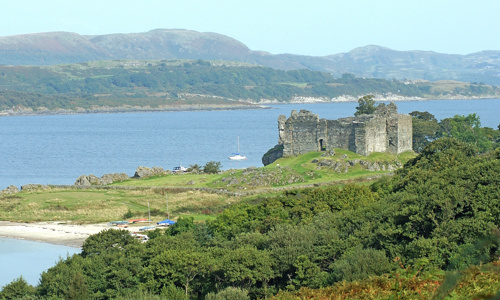History
Kilberry’s sculptured stone collection is thought to have come from the site of the medieval parish church on the Kilberry Castle estate, a little to the east of the castle itself.
The church is first mentioned in about 1350. It was burnt down in the 1640s by the Campbells of Kilberry to prevent the besieging Royalist force of Alistair MacDonald making use of it. The churchyard fell into disuse in the following century and probably now lies under the bowling green.
The stones were moved to the castle’s basement in 1948 by local historian and archaeologist Marion Campbell of Kilberry, who invited the Ministry of Works to take them into State care. They were moved from the basement to the current purpose-built shelter in 1951.
Spanning the ages
The collection comprises 26 sculptured stones along either side of the central wall. It includes:
- three early Christian gravemarkers, all cross-marked
- eight medieval grave slabs, some complete, some fragments. These are decorated in the elaborate West Highland tradition. They’re dated to between the 1300s and 1500s
- fragments of eight crosses, including the Kilberry Cross
- seven irregularly-shaped post-medieval slabs
Of the medieval slabs, two feature effigies of armed warriors, one with an inscription commemorating John, son of Mauritius. Mauritius is a Latinised version of the Gaelic name Muiredach or Murchad. It was common among the MacMurachies, who are said to have held Kilberry at one point.
The Kilberry Cross
The cross-shaft fragment called the Kilberry Cross is a metre high. One face shows:
- a mounted warrior on a rearing horse at the bottom
- a cleric wearing robes and mitre in the centre, with one hand raised in benediction and the other holding an archbishop’s shaft in the centre
- a second robed figure at the top
The other face is decorated with a leaf scroll looping around a pair of prancing lions at the base of a cross.











